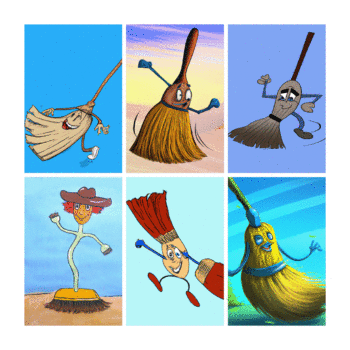Hamma kinne Hamma, näme mer dä Zang* — or: Why a certain logic of thinking is what makes us creative beings in the first place.
If you Google the term “sloppy thinking,” you will only get uses of the term with negative connotations. Sloppy thinking is faulty, inconsistent, illogical, lumpy, sometimes spiritless and unmotivated. Someone has been sloppy. “Sloppy,” after all, sounds kind of fringy, inaccurate, messy, and not very desirable. Instead, it’s better to think things through conscientiously, precisely, straightforwardly, with a clear head and razor-sharp mind. Should we?
Yet we can hardly get through everyday life without sloppy thinking. Especially when it comes to creative processes, a certain sloppiness of thinking is extremely helpful, because it makes it possible to establish deviating connections, to see things in a new and different way, to approach problems more flexibly and vividly.
I will give you an example of a “problem” which you can solve only with sloppy thinking: Imagine that the two politicians Armin Laschet and Markus Söder are both the number 10, but the 10 is composed differently. For one of them, the 10 consists of 8+2, and for the other of 7+3. Now it’s your turn: which 10 is Laschet’s and which is Söder’s?
Sloppy thinking is a peculiarity of a certain way of approaching problems, making connections, creating order, opening up the world, for which there are many names: Intuitive, analogical, lateral, concrete, transversal, mimetic, sensual, psychesthetic, wild, dreamlogical, and many more: thinking that follows the rules of perception, the senses, and physicality rather than those of formal logic and verbal language, that is comparative rather than discursive — and thus represents a different mode of what in psychology is called cognition.
A central principle of analogical, sensory thinking is its tolerance of fuzziness and ambiguity (there is also the term fuzzy logic, sounds nice and sloppy too). We have no hesitation to recognize a circle in the view of an apple, although the apple only passes as circular with the best will in the world — or in fuzzy logic. In diffuse clouds we recognize faces or in an advertisement similarities to a hero story. Here a poster, there a novel, we don’t take it too seriously.
This thinking in vague similarities — or ‘thinking over the edge’ as in sloppy painting — is precisely what gives us more freedom. If I want to hang a painting and don’t have a hammer handy, then something somehow similar will do, as long as it’s heavy and hard and fits well in the hand. Isomorphism, the recognition of structural similarity, only works if you don’t take it so narrowly. In Cologne they say: Hamma kinne Hamma, näme mer dä Zang (Cologne dialect for: If we don’t have a hammer, we take the tongs).
The nice thing about it is: thinking laxly, tasks and solutions can also be twisted and turned in the imagination without constraint. If you walk through the world with creative glasses, you can be inspired by everything possible and somehow-distantly-similar. Besides, we can use a huge pool of memories, ideas and associations that come to us, even if they have only remotely something to do with our problem. What the heck. If it helps?
The criterion for a good idea is not correctness but coherence. For the task with Laschet and Söder, there is no correct result, only a coherent one, and — if you were to make a poll out of it — you wouldn’t have a 100% result, because coherence is only approximate. Sloppy.
Of course, other aspects are important for creativity, and sloppy thinking does not mean to approach problem solutions haphazardly and unsystematically. But that is another topic.
Further details:
In our study “Psychology of Creativity” we describe creative thinking as “sloppy thinking”, among other things. The study is available here for free download (in German language).
The term can be found for the first time in a book by Ursula Brandstätter: “Erkenntnis durch Kunst. Theorie und Praxis der ästhetischen Transformation” (2013): “Thinking alongside, thinking sloppily, thinking at the fuzzy edges — all these ways of thinking open up new spaces of thought beyond the firmly defined boundaries of conventionalized thinking” (p. 51). Brandstätter is rector of the Anton Bruckner Private University for Music, Drama and Dance in Linz/Austria.
The term “uncertainty tolerance” of visual thinking was introduced into psychology by Max J. Kobbert, following the remarks of Gestalt psychologist Rudolf Arnheim. Kobbert was a professor of perceptual psychology at the Münster Academy of Art and Münster University of Applied Sciences in the Design Department until 2009.
We also describe fuzzy tolerance in detail and with practical relevance for designers in our book „Wie Design wirkt“ (here is a free chapter).
The idea of fuzzy logic goes back to Plato, who used it to describe solutions that lie in a third realm between true and false (and who thus contradicted his student, the formal logician Aristotle). It plays an important role today in the field of artificial intelligence.
The task with the politicians and the number 10 is inspired by the essay “Inspiration” by Friedrich W. Heubach. Heubach was a psychology professor at the University of Cologne (during my studies there) and then at the Hochschule für bildende Künste in Hamburg and the Kunstakademie Düsseldorf. Heubach was one of my most important teachers and also supported us at INNCH as a supervisor.
* Translation for non-Colognians: “If we don’t have a hammer, we take the tongs”
(ms)






















































